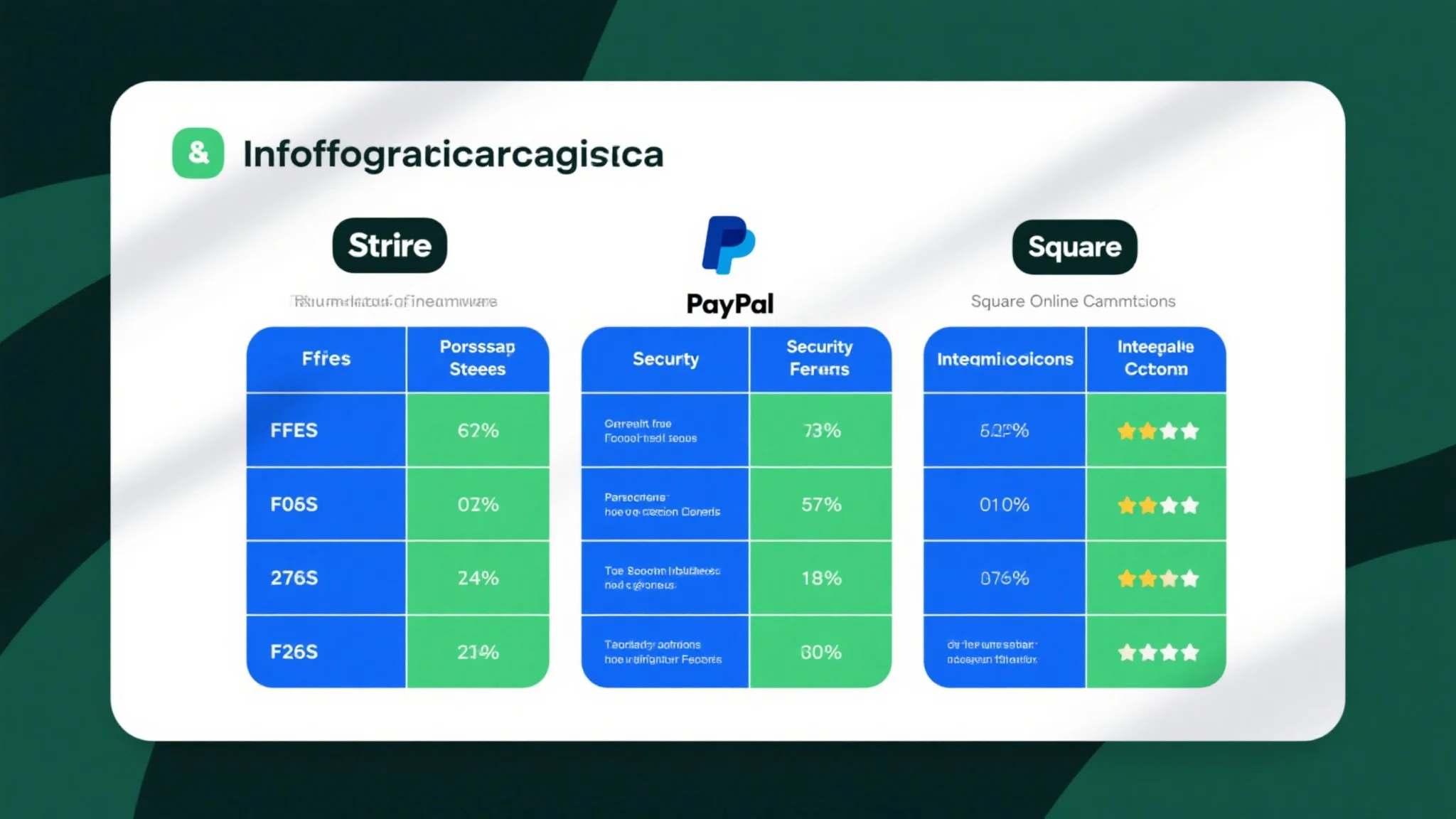Choosing the right online payment system is crucial for businesses aiming to streamline their transactions and ensure customer satisfaction. This article provides a comprehensive comparison of three of the most popular payment systems: Stripe, PayPal, and Square. By evaluating their features, target audiences, pricing models, security, and integration capabilities, you can make an informed decision that aligns with your business needs.

Stripe, PayPal, Square, online payment systems, comparison, business needs, security, integration, pricing.
Features, Security, and Integration
Stripe
Stripe is a leading payment processing platform that has become synonymous with handling transactions for digital businesses. It offers a robust suite of features, making it a popular choice for developers, startups, and e-commerce platforms. Stripe provides tools for accepting credit and debit payments, recurring subscriptions, and even cryptocurrency transactions. Its integration capabilities extend to popular platforms like WordPress and Shopify, making it a versatile option for businesses of all sizes.
One of Stripe’s standout features is its low processing fees, which are typically between 1.5% and $\textdollar$2.95 per transaction. This makes it an ideal choice for businesses looking to minimize transaction costs. Additionally, Stripe’s security features are top-notch, with 256-bit encryption and PCI-DSS compliance. This ensures that sensitive customer data remains protected from unauthorized access.
Stripe’s developer-friendly API is another significant advantage. Developers can integrate Stripe into their applications with ease, leveraging its extensive documentation and developer tools. For businesses that rely heavily on APIs for real-time functionality, Stripe’s robust ecosystem is a game-changer.
PayPal
PayPal, on the other hand, is a well-known payment processing service that has been around for over two decades. It is widely used by individuals, businesses, and e-commerce platforms for instant payments. PayPal offers a user-friendly interface, making it accessible to both seasoned professionals and casual users. Its instant payment feature allows transactions to complete within seconds, which is a significant advantage for businesses aiming to reduce customer wait times.
PayPal’s security measures are also noteworthy. It uses 256-bit encryption and integrates with SSL for secure transactions. For businesses that prioritize user trust, PayPal’s reputation as a trusted payment system is hard to challenge. It also offers features like gift cards and international payment support, which can be beneficial for global businesses.
However, PayPal’s reliance on a centralized system can be a drawback for businesses that require more granular control over their payment processing. Additionally, its pricing model includes fees for using PayPal Plus, which offers premium features like bill Pay and recurring payment options.
Square
Square is another prominent payment processing platform that has gained traction in recent years due to its ease of use and comprehensive features. Square offers both payment processing and acceptance, making it a one-stop solution for businesses. It supports credit and debit payments, bill Pay, and even cryptocurrency transactions, similar to Stripe.
Square’s pricing model is transparent and competitive. For example, Square Card, which is integrated with Square Point, offers transaction fees of 1.5% plus $\textd$\textdollar$2.60 per transaction. This is slightly higher than Stripe’s fees but offers additional features like business checking accounts and business credit cards. Square’s checking accounts allow businesses to manage their finances directly from their Square apps, which is a significant advantage for small to medium-sized businesses.
One of Square’s strongest points is its strong customer support. Square is known for its user-friendly interface and helpful customer service, making it a popular choice for businesses that prioritize ease of use. Additionally, Square integrates seamlessly with other business tools like QuickBooks and Xero, enhancing its appeal for accountants and small business owners.
Pricing, Ease of Use, Transaction Speed, and Additional Services
Stripe
Stripe’s pricing is straightforward and transparent. While it does not offer a free tier, its pricing model is based on transaction volume. For individual users, Stripe charges a transaction fee of 1.5% plus $\textdollar$2.95 per transaction, with no monthly recurring fees. For businesses that require more advanced features, Stripe offers Stripe Business, which includes additional tools like business credit cards and a dedicated account manager.
Stripe’s ease of use is another strength. Its API is well-documented, and it offers ample developer tools for integrating Stripe into applications. However, the lack of a free tier might be a barrier for small businesses with limited budgets. Despite this, the benefits of Stripe’s robust features and low fees often outweigh the cost.
In terms of transaction speed, Stripe is known for its fast processing times, with transactions typically clearing within 24 hours. This is particularly beneficial for businesses that rely on real-time transaction confirmations, such as online marketplaces and e-commerce platforms.
PayPal
PayPal’s pricing structure is designed to cater to a wide range of users, from individuals to large enterprises. For individuals, PayPal charges transaction fees of 2.9% plus $\textdollar$2.50 per transaction for standard payments, and 2.9% plus $\textdollar$3.95 per transaction for PayPal Plus. For businesses, PayPal offers similar pricing structures, with transaction fees ranging from 1.99% to 3.5% depending on the region.
While PayPal’s pricing is slightly higher than Stripe’s, its additional features, such as PayPal Plus and bill Pay, make it a more comprehensive solution for businesses. PayPal Plus, for example, provides recurring payment options, bill Pay, and international payment support, which can be invaluable for global businesses.
The transaction speed of PayPal is also impressive, with payments typically clearing within 24 hours. However, PayPal’s reliance on a centralized system can sometimes lead to longer processing times for complex transactions, especially for businesses that require multiple payment methods.
Square
Square’s pricing is more transparent and user-friendly, with no hidden fees. For individuals, Square Card transactions cost 1$\textdollar$ fee per transaction, with transaction fees ranging from 1.5% to 2.5%. For businesses, Square offers Square Card Business, which includes transaction fees of 1.5% plus a fixed fee of $\textdollar$25 per transaction, plus a $\textdollar$10 monthly fee for Square Business Pay.
Square’s pricing model is one of its strongest features, as it provides value at every tier. For example, Square’s Business Checking Account offers unlimited business checks and reconciliation tools for $\textdollar$99.95 per month, making it a cost-effective solution for small businesses.
In terms of transaction speed, Square is known for its fast processing times, with transactions clearing within 24 hours. Square’s integration with popular business tools like QuickBooks and Xero further enhances its appeal for accountants and small business owners.
Additional services like Square Business Pay and Square Capital provide businesses with tools to manage their cash flow and grow their business, making Square a versatile solution for various business needs.
Choosing the right online payment system depends on your business’s specific needs, budget, and desired features. Stripe, PayPal, and Square each offer unique advantages that cater to different types of businesses.
Stripe is ideal for developers and businesses that prioritize security and integration, with its low fees and robust API. PayPal is a strong choice for businesses that require user trust and instant transaction speed, with its comprehensive features and strong customer support. Square offers a user-friendly, all-in-one solution with competitive pricing and strong integration with other business tools.
By evaluating your business’s unique requirements, you can select the payment system that provides the tools and security you need to succeed in today’s digital economy.


